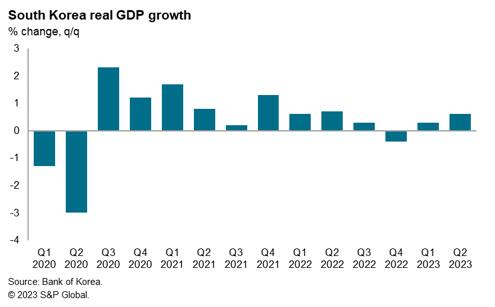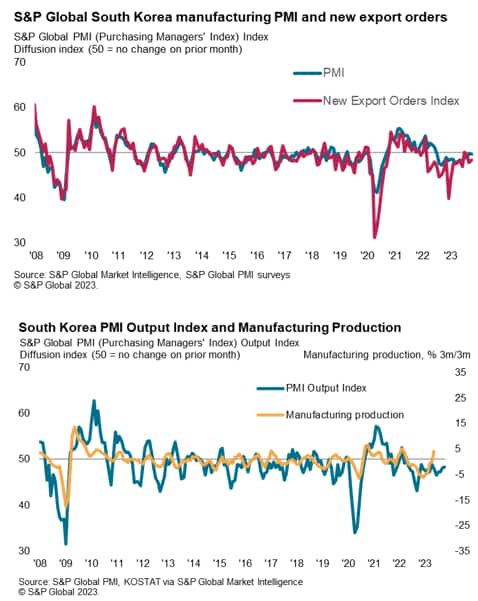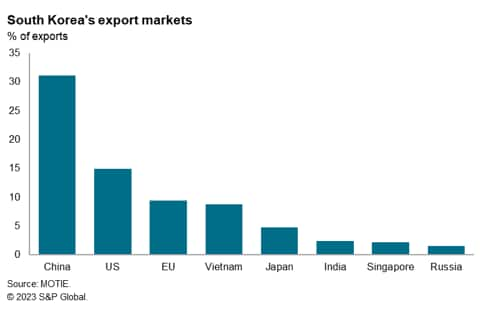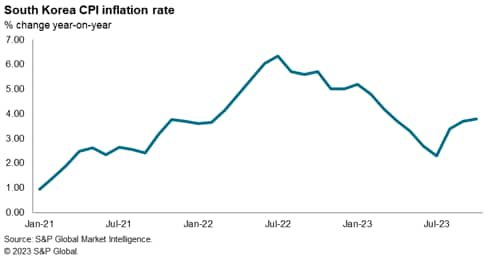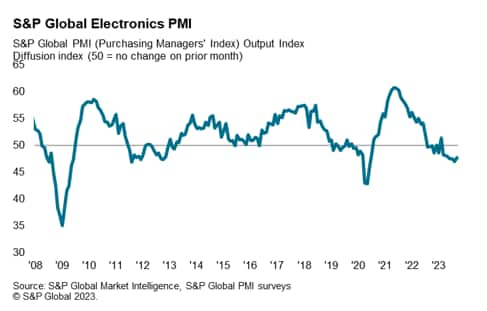Customer Logins
Obtain the data you need to make the most informed decisions by accessing our extensive portfolio of information, analytics, and expertise. Sign in to the product or service center of your choice.
Customer Logins
ECONOMICS COMMENTARY
Nov 03, 2023
South Korea's exports rebound in October 2023
South Korea's exports grew by 5.1% year-over-year (y/y) in October 2023, the first positive expansion recorded since September 2022. The rebound in exports was helped by strong growth in exports of autos and petroleum products.
Anaemic economic growth in the European Union (EU) and sluggish domestic demand in mainland China during 2024 remain a key downside risk for South Korea's manufacturing export sector. South Korea's exports to mainland China have remained weak during 2023, recording a decline of 9.5% y/y in October. However South Korea's tourism sector has been strengthening during 2023 and is expected to show further improvement during 2024, as international tourist travel in the Asia-Pacific region continues to recover.
GDP growth improves in the second quarter of 2023
South Korea's real GDP grew by 0.6% quarter-over-quarter (q/q) in the second quarter of 2023, improving on the 0.3% q/q rate recorded in the first quarter of 2023 and the GDP contraction of 0.3% q/q in the fourth quarter of 2022.
However, beneath the topline growth number, the second-quarter GDP data showed considerable underlying weaknesses in the South Korean economy. Notably, final consumption expenditure contracted by 0.6% q/q in the second quarter, after rising by 0.6% q/q in the first quarter. Private consumption showed a slight contraction of 0.1% q/q in the second quarter, after rising by 0.6% q/q in the first quarter. Reflecting this slowdown, private consumption expenditure rose by just 1.5% y/y in the second quarter, after growing at a pace of 4.6% y/y in the first quarter.
Exports of goods and services also contracted, declining by 1.8% q/q in the second quarter, after posting positive growth of 4.5% q/q in the first quarter.
On an industry sector basis, manufacturing output rose by 2.8% q/q in the second quarter of 2023, improving on the 1.3% q/q growth rate recorded in the first quarter of 2023 and a significant turnaround from the 3.9% q/q contraction in the fourth quarter of 2023. Nevertheless, manufacturing output recorded a marginal decline of 0.5% y/y.
Construction output contracted by 3.4% q/q in the second quarter of 2023, after three consecutive quarters of positive q/q growth. However, construction output was still up 4.6% y/y in the second quarter of 2023.
The services sector showed marginal positive growth of 0.2% quarter over quarter in the second quarter of 2023, although still improving on the zero quarter-over-quarter growth rate in the first quarter. Services output rose by 1.9% y/y in the second quarter of 2023, moderating from the 3.4% y/y growth rate recorded in the first quarter.
Monthly industrial production statistics for August showed a rebound in South Korean manufacturing output, which rose by 5.5% y/y, after a 2% y/y decline in July.
The seasonally adjusted South Korea Manufacturing Purchasing Managers' Index (PMI) has shown a gradual improvement since the beginning of 2023, although the reading for October edged down to 49.8 in October from 49.9 in September, rate of decline in the sector was marginal and just below the neutral mark of 50.0.
South Korea's export sector, which accounts for an estimated 38% of GDP, has faced continuing headwinds during 2023 owing to weak economic growth momentum in the US and EU and the slowdown in the global electronics cycle.
However, there are some signs of a turnaround. According to latest trade data from South Korea's Ministry of Trade, Industry and Energy, South Korea's merchandise exports showed grew by 5.1% y/y in October 2023. Auto exports were buoyant, rising by 19.8% y/y in October, while exports of petroleum products rose by 18% y/y. The pace of decline of semiconductors exports also moderated in October, albeit still showing a year-over-year contraction.
As the US and EU are among South Korea's largest export markets, weak economic growth in these markets since mid-2022 have been a negative factor for South Korea's manufacturing export sector. The latest export data painted a mixed picture for these two key markets, with exports to the US rising by 17.3% y/y in October, while exports to the EU declined by 10.7% y/y.
During the second half of 2022, moderating economic growth in mainland China due to the impact of pandemic-related restrictive measures on domestic demand had been an important factor contributing to weaker external demand for South Korean exports, since mainland China is South Korea's largest export market. In calendar year 2022, South Korean exports to mainland China fell by 4.4% y/y, having deteriorated considerably in late 2022 and early 2023.
South Korean exports to mainland China have remained weak in 2023. With the moderate pace of recovery continuing to constrain domestic demand in mainland China, total South Korean merchandise exports to that key market fell by 9% y/y in October, albeit significantly improved on the 19% y/y decline in June.
South Korean exports to Association of Southeast Asian Nations (ASEAN) also fell sharply, declining by 13.9% y/y in June, hit by impact of the slump in Vietnam's electronics exports on South Korean manufacturing supply chains. Due to the importance of Vietnam as a hub for South Korean manufacturing, total South Korean exports to Vietnam reached USD 61 billion in 2022. However, with the downturn in Vietnam's manufacturing exports during the first half of 2023, South Korean exports to Vietnam have also been declining.
However, an important factor that will help to mitigate the impact of weak goods exports will be the upturn in international tourism during 2023-24. International tourist arrivals rose above 1 million visitors in July 2023, the first time that visitor numbers exceeded the 1 million mark since the start of the COVID-19 pandemic. Prior to the COVID-19 pandemic, tourism accounted for around 4.7% of South Korea's GDP, with mainland China and Japan being key tourism source markets. Total international tourist visitor arrivals reached a record high of 17.5 million in 2019, averaging around 1.46 million arrivals per month.
South Korean CPI inflation had risen significantly during 2022, largely reflecting the impact of the Russia-Ukraine war on global commodity prices, particularly for oil and gas. The annual average CPI inflation rate of 5.1% for 2022 compared with an average CPI inflation rate of 2.5 percent in 2021. The 2022 average CPI inflation rate was the highest annual average since 2011.
Due to the upturn in inflation pressures during 2022, the Bank of Korea (BOK), South Korea's central bank, tightened monetary policy seven times in 2022, lifting the Base Rate to 3.25%. At its January meeting, the Monetary Policy Board of the BOK decided to raise the Base Rate by a further 25 basis points (bps), raising the Base Rate to 3.50%. This has brought total cumulative tightening to 300bps since August 2021. This has impacted domestic demand, with household lending having continued to decrease owing to rising interest rates and falling prices in the residential property market.
In the first half of 2023, inflation pressures had eased. South Korea's headline CPI inflation rate moderated to 2.7% y/y in June 2023, compared with 3.7% y/y in April and a recent peak of 6.3% y/y in July 2022. However, with world oil prices and some food prices having rebounded since July 2023, South Korea's CPI inflation rate has risen again to reach a pace of 3.8% y/y in October 2023. The Monetary Policy Board of the BOK decided at its April, May, July, August and October meetings to leave the Base Rate unchanged at 3.50%. In its October 2023 Monetary Policy Decision, the Monetary Policy Board assessed that consumer price inflation will fall to the lower 3% range by the end of 2023.
According to the October PMI survey, input cost inflation strengthened for the second successive month at the start of the fourth quarter. Input price inflation accelerated to the strongest since December 2022 and was often attributed to higher raw material prices and currency weakness. Concurrently, factory gate charges were raised for the second month in a row.
The recent rebound of the Korean won against the USD has also helped to somewhat mitigate the upside risks to inflation. The KRW had depreciated from 1,189 against the USD on 1st January 2022 to 1,428 by 12th October 2022 but has since appreciated slightly to 1,353 by the end of October 2023.
Electronics sector downturn hits South Korean exports
The electronics manufacturing industry is an important part of the manufacturing export sector for South Korea which is one of the world's leading exporters of electronics products to key markets such as the US, China and EU. As Vietnam is an important production hub for South Korean electronics multinationals such as Samsung and LG for a wide range of electronics products such as mobile phones, Vietnam is also a key export market for South Korean electronics components.
Exports of South Korea's information and communications technology (ICT) goods for calendar year 2022 amounted to USD 233 billion, up 2.5% y/y and accounting for 34.1 percent of South Korea's total merchandise exports. However, deteriorating global economic conditions through the course of 2022 resulted in weaker ICT exports in late 2022, with ICT exports in December 2022 down 23.6% y/y.
South Korea's ICT exports have remained weak in the third quarter of 2023. South Korea's Ministry of Trade, Industry and Energy trade data showed that exports of ICT goods in September 2023 were USD 18.1 billion, down 13.4 per cent y/y.
However, there were early signs of improvement for semiconductors exports in October 2023, with the pace of contraction in export values moderating to a decline of 3.1% y/y, compared with a contraction of 14.4% y/y in September.
The downturn in South Korea's ICT exports reflects the slowdown in the global electronics industry since mid-2022. The headline seasonally adjusted S&P Global Electronics PMI posted 47.7 in September, up slightly from 47.0 in August but still signalling a continued contraction in the global electronics sector. Incoming new orders placed with electronic manufacturers fell on the back of softening economic conditions, elevated prices and inventory destocking efforts at clients, according to survey respondents. The rate of decline remained strong, though easing from August. New orders in the Consumer segment fell at the most pronounced pace, followed by Computing and Industrial. All four monitored segments recorded a softer rate of contraction, however.
Near-term economic outlook
South Korean GDP growth is forecast to moderate from 2.6% in 2022 to 1.3% in 2023, according to the latest forecast by S&P Global Market Intelligence. In May, the Bank of Korea revised down its GDP forecast for 2023 to 1.4% and has maintained its GDP forecast at 1.4% in its October Monetary Policy Statement.
South Korea's export sector, which accounts for an estimated 38% of GDP, faced continuing headwinds during the first nine months of 2023 due weak economic growth momentum in mainland China and EU and the slowdown in the global electronics cycle. However, there was a significant improvement in semiconductors exports in October. The near-term outlook for South Korean goods exports remains constrained by weak demand conditions in the EU, as well as the relatively moderate pace of economic recovery in mainland China. However, there may be some further gradual improvement in electronics exports during H1 2024. One area of strength has been auto exports, which rose by 9.5% y/y in September and were up 35.8% y/y in the first nine months of 2023. This reflected strong exports of electric vehicles, with the number of electric vehicles exported in September rising by 33.5% y/y while exports of plug-in hybrid electric vehicles rose by 93.4% y/y.
Due to the upturn in inflation pressures since late 2021, the Bank of Korea has tightened monetary policy by 300bps since August 2021, which has lifted the Base Rate to 3.50%. Higher policy rates have also resulted in a cooling property market, with South Korean apartment prices estimated to have declined by 4.7% y/y in 2022 according to the Real Estate Board. For the eleven months to April 2023, South Korean housing prices declined by 8.5% y/y. However, housing price data for July and August showed marginal rises, signalling that the downturn in housing prices may have bottomed out.
Medium-term outlook and key risks
Over the medium-term outlook, South Korean exports are expected to resume growing at a rapid pace, helped by the sustained strong growth of intra-regional trade within APAC, as China, India and ASEAN continue to be among the world's fastest-growing emerging markets. South Korea's strong competitive advantage in exporting key electronics products, notably semiconductors and displays, as well as autos and auto parts, are expected to be an important positive factor underpinning export growth.
The rapid growth of South Korean exports is also expected to be strengthened by the APAC regional trade liberalization architecture. This includes the large recent RCEP multilateral trade agreement and major bilateral FTAs. The RCEP trade deal, which South Korea has ratified, entered into effect from 1st January 2022 for the first ten ratifying members, and from 1st February 2022 for South Korea.
An important macroeconomic risk to the South Korean economy over the medium to long-term outlook continues to be from the high level of household debt as a share of GDP. This has risen to 104.9% by mid-2023, according to BOK data. A key factor driving this debt ratio higher has been large mortgage lending flows for residential property purchases. Such a high household debt ratio creates macroeconomic vulnerability to significant monetary policy tightening, with Bank of Korea rate hikes during 2021-23 having increased financial pressures on highly leveraged households.
Managing the energy transition towards renewable energy is also a key policy priority for South Korea. South Korea has already been at the forefront globally in planning initiatives to develop hydrogen as a key future fuel source for domestic power generation.
Among South Korea's greatest economic challenges will be long-term demographic ageing, which will have severe implications for South Korea's economy and society. The number of seniors aged 65 or over has already reached 16.5% of the population and by 2025 is projected to rise to 20% of the population. Meanwhile the working age population (aged 15 to 64) is declining as a share of the total population, from 71.4% in 2021 to a projected 55.7% by 2041.
Demographic ageing has already contributed to the moderation of South Korea's potential GDP growth rate from around 7% per year in the mid-1990s to around 2.5% per year by 2021. South Korea's potential growth rate could drop to a range of around 1% to 1.5% per year by 2050 due to demographic ageing.
Consequently, structural reforms to increase the potential growth rate will be a key policy priority over the medium term. These reforms would include policy changes to lift the labour force participation rate, improve services sector productivity, accelerate digitalization and further boost the adoption of industrial automation.
Access the South Korea Manufacturing PMI press release here.
Rajiv Biswas, Asia Pacific Chief Economist, S&P Global Market Intelligence
© 2023, S&P Global. All rights reserved. Reproduction in whole
or in part without permission is prohibited.
Purchasing Managers' Index™ (PMI®) data are compiled by S&P Global for more than 40 economies worldwide. The monthly data are derived from surveys of senior executives at private sector companies, and are available only via subscription. The PMI dataset features a headline number, which indicates the overall health of an economy, and sub-indices, which provide insights into other key economic drivers such as GDP, inflation, exports, capacity utilization, employment and inventories. The PMI data are used by financial and corporate professionals to better understand where economies and markets are headed, and to uncover opportunities.
This article was published by S&P Global Market Intelligence and not by S&P Global Ratings, which is a separately managed division of S&P Global.
{"items" : [
{"name":"share","enabled":true,"desc":"<strong>Share</strong>","mobdesc":"Share","options":[ {"name":"facebook","url":"https://www.facebook.com/sharer.php?u=http%3a%2f%2fwww.spglobal.com%2fmarketintelligence%2fen%2fmi%2fresearch-analysis%2fsouth-koreas-exports-rebound-in-october-2023-nov23.html","enabled":true},{"name":"twitter","url":"https://twitter.com/intent/tweet?url=http%3a%2f%2fwww.spglobal.com%2fmarketintelligence%2fen%2fmi%2fresearch-analysis%2fsouth-koreas-exports-rebound-in-october-2023-nov23.html&text=South+Korea%27s+exports+rebound+in+October+2023+%7c+S%26P+Global+","enabled":true},{"name":"linkedin","url":"https://www.linkedin.com/sharing/share-offsite/?url=http%3a%2f%2fwww.spglobal.com%2fmarketintelligence%2fen%2fmi%2fresearch-analysis%2fsouth-koreas-exports-rebound-in-october-2023-nov23.html","enabled":true},{"name":"email","url":"?subject=South Korea's exports rebound in October 2023 | S&P Global &body=http%3a%2f%2fwww.spglobal.com%2fmarketintelligence%2fen%2fmi%2fresearch-analysis%2fsouth-koreas-exports-rebound-in-october-2023-nov23.html","enabled":true},{"name":"whatsapp","url":"https://api.whatsapp.com/send?text=South+Korea%27s+exports+rebound+in+October+2023+%7c+S%26P+Global+ http%3a%2f%2fwww.spglobal.com%2fmarketintelligence%2fen%2fmi%2fresearch-analysis%2fsouth-koreas-exports-rebound-in-october-2023-nov23.html","enabled":true}]}, {"name":"rtt","enabled":true,"mobdesc":"Top"}
]}





